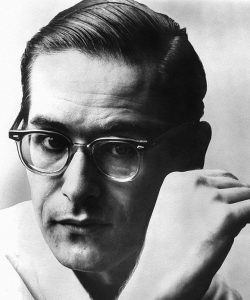George Russell Day
June 23, 1923 – July 27, 2009
“Stratusphunk”
Click here if you have a memory of this artist that you’d like to share
Click here to Support Jazz on the Tube
Pianist, composer, arranger, and theorist George Allen Russell was born on June 23, 1923, in Cincinnati, Ohio. He grew up immersed in music, hearing the tunes played on Ohio River riverboats and in the African Methodist Church, where he sang in the choir from a young age.
Sick with tuberculosis during WWII, he spent his time in the hospital learning music theory. After the war, in NYC, he became part of the group (including Miles Davis and Charlie Parker) who spent time at the home/studio of Gil Evans.
Regarding Russell’s innovations in music theory:
A remark made by Miles Davis in 1945, when Russell asked him about his musical aim, led Russell on a quest that became his life’s work. Davis responded that his aim was “to learn all the changes.” Knowing that Davis already knew how to arpeggiate each chord, Russell reasoned that he meant he wanted to find a new and broader way to relate to chords.
Russell codified the modal approach to harmony, inspired by this casual remark from the eighteen-year-old Miles Davis in 1944. Davis had said he wanted to learn all the changes, and Russell reasoned that he might try to find the closest scale for every chord. Davis popularized these liberating ideas in recordings like Kind of Blue, undermining the entire harmonic foundation of bop that had originally inspired both him and Russell.
Miles reportedly summarized the Lydian Chromatic Concept (LCC) succinctly by saying, “F should be where middle C is on the piano”—in other words, F to F (the white notes on a piano) represents the Lydian scale rather than the major scale (C to C).
Russell’s theory proposes the concept of playing jazz based on scales or a series of scales (modes) rather than chords or harmonies. The Lydian Chromatic Concept explored the vertical relationship between chords and scales and was the first codified original theory to come from jazz. Russell’s ideas influenced the development of modal jazz, notably in the album Jazz Workshop (1957, with Bill Evans and featuring the “Concerto for Billy the Kid”) as well as his writings. Evans later introduced the concepts to other members of Miles Davis’s working band, which employed them in recordings beginning with the album Kind of Blue.
Russell’s Lydian Concept has been described as providing resources rather than imposing constraints on musicians. “The Lydian Chromatic Concept is one of the two most splendid books about music; the other is My Musical Language by Messiaen. Though I’m considered a contemporary music composer, if I dare categorize myself as an artist, I’ve been strongly influenced by the Lydian Concept, which is not simply a musical method—we might call it a philosophy of music, or we might call it poetry.”
The major scale probably emerged as the predominant scale of Western music because within its seven tones lies the most fundamental harmonic progression of the classical era, thus resolving to its tonic major chord. The Lydian scale, by contrast, is the sound of its tonic major chord.
–
Click here if you have a memory of this artist that you’d like to share


